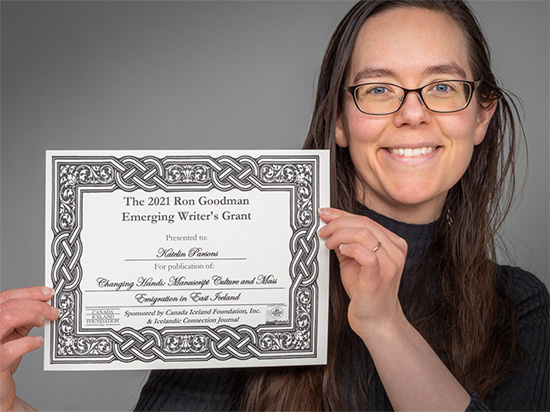 Growing up in Winnipeg, Iceland always had a central presence on the vaguely imagined map of Europe, together with Poland and Ukraine, but I didn’t come from an Icelandic background or know about the history of New Iceland beyond the Íslendingadagurinn festival. When I was around 13 years old, I discovered an old Icelandic book in a used bookstore in St. Francois Xavier. It was tiny and fragile and had been sewn together from three different poetry booklets. One of those poetry booklets was handwritten, in a beautiful flowing script. I couldn’t read a word, but I fell under its spell. Twenty-five years later, the stories of these books and how they came to Canada with their immigrant owners are still what drives my research, and opening a handwritten manuscript for the first time still brings the same kid-like excitement.
Growing up in Winnipeg, Iceland always had a central presence on the vaguely imagined map of Europe, together with Poland and Ukraine, but I didn’t come from an Icelandic background or know about the history of New Iceland beyond the Íslendingadagurinn festival. When I was around 13 years old, I discovered an old Icelandic book in a used bookstore in St. Francois Xavier. It was tiny and fragile and had been sewn together from three different poetry booklets. One of those poetry booklets was handwritten, in a beautiful flowing script. I couldn’t read a word, but I fell under its spell. Twenty-five years later, the stories of these books and how they came to Canada with their immigrant owners are still what drives my research, and opening a handwritten manuscript for the first time still brings the same kid-like excitement.
I joined the Scandinavian Canadian Choir when I was in high school, and it was through music that I first got to know Icelandic. Kendra, Christine, Kristín, Susan, and the other choir members were an amazing support and an inspiration to learn more. I signed up for beginner Icelandic classes at the Scandinavian Cultural Centre of Winnipeg with Gunnvör Daníelsdóttir, and as an undergraduate student at the University of Manitoba I studied Icelandic with Kristín Jóhannsdóttir. Kristín and others encouraged me to apply for a scholarship to study Icelandic at the University of Iceland. It was this scholarship that brought me to Iceland in 2003 – and I’ve never left.
Receiving the scholarship was an honour and a chance to learn more about Icelandic language, culture, and literature. I was also lucky enough toget a summer job in a public library in Reykjavík after graduating. Helping library patrons all day made a huge difference for understanding spoken Icelandic.
My next degree was in translation studies. Although the idea was to take a practical degree for a career that wouldn’t leave me deep in student debt, things took an unexpected turn when I finally discovered Icelandic manuscripts as an area of study. I first took a course in manuscript studies in 2007 and participated at a summer school at the Èrni Magnússon Institute for Icelandic Studies. For anyone who loves books, it’s almost impossible not to love manuscripts, but reading eighteenth- and nineteenth-century handwriting can be incredibly difficult.
In 2009, I discovered that the University of Manitoba has a huge collection of immigrants’ manuscripts, and this was the beginning of a journey of discovery to find the many manuscripts that Icelandic men and women had brought with them across the Atlantic but aren’t well known to students and researchers. The Fragile Heritage Project at the Èrni Magnússon Institute began in 201, thanks to a major three-year grant from the Eimskip Foundation. The Eimskip Foundation was originally established by Canadians and Americans of Icelandic descent.
Today, the Eimskip Foundation supports Ph.D. research in Iceland, and the grant supported fieldwork by me and three other doctoral students in Canada and the U.S. It was a unique opportunity that came just in time: the pandemic would have made our work impossible.
I graduated from the University of Iceland in November 2020 and have had the good fortune to continue at the Èrni Magnússon Institute, working with my wonderful Ph.D. supervisor, Dr. Margrét Eggertsdóttir. The idea for writing a full-length book on manuscript culture in East Iceland and the effect of mass immigration to North America originally developed from my Ph.D. research on Icelandic poetry.
East Iceland is a region of the country that often gets minimal attention in manuscript research, but many immigrant manuscripts come from East Iceland, which is not surprising given the large numbers of immigrant families who came from this part of Iceland. I hope that the book will capture an untold but important story in the shared history of Iceland and North America, and I am extremely grateful for the writer’s grant to turn this book project into a reality.
Katelin is currently finalizing her manuscript for publication.
